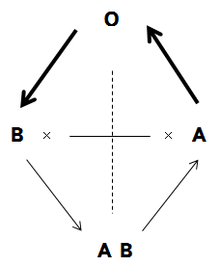Masahiko Nomi
Masahiko Nomi (能見 正比古 Nomi Masahiko, July 18, 1925 – October 30, 1981) was a Japanese journalist who advocated Takeji Furukawa's idea of an influence of blood type on personality.[1] He was also known as a sumo essayist.
History
Nomi was born in Kanazawa, Ishikawa in 1925. He graduated from the engineering faculty of University of Tokyo, and after the graduation he enrolled to the law faculty of the same university. During this time he started his career as a writer.
His first book on the subject, Ketsueki-gata de Wakaru Aisho (Understanding Affinity by Blood Type) became a best seller in 1971. He wrote more than ten popular books. After his death in 1981, his son, Toshitaka Nomi inherited the study.[2] He established the Human Science ABO Center in 2004.
Blood Type Humanics
.png)
.png)


Summary
Blood-type research carried out during the 1920s and '30s in Germany,[3] obstensively focussed on how to recognise blood of non-Aryan origins during the newly emerging medical procedure of blood transfusions resurfaced in the "Age of Aquarius" era Japan. Removing the ethno-racial aspect, Nomi focussed instead on the idea that blood types are linked to specific character types and behaviour patterns, and then went on to write a book around what he termed "血液型人間学" ("Blood Type Humanics). The book was hugely popular in Japan with the core idea of blood type = personality type becoming firmly embedded in Japanese popular culture and those of other Asian countries. While seeming quaint and harmless, cases of Japanese workers finding themselves on the receiving end of workplace issues arising from being of the "wrong" blood type is common enough for the phrase "bura hara" ("ブラハラ"), an abbreviation of "blood harassment", to be coined.[4]
Introduction
A humorous simile of foods was introduced to help people get an image easily. He compared the human being as vegetables. In this way, there are a lot of kinds of vegetables, therefore there are various kinds of personalities for the same blood type. Type O people are fresh vegetables. Personalities of type O appears most, because fresh vegetables are not processed therefore variety is the richest among four blood types. Type A people are pickles. Properties of original vegetables remain even if fresh vegetables are processed to pickles. However, common properties of pickles do not change even if properties of fresh vegetables are controlled to a certain degree by processing. Type B people are boiled (and seasoned) vegetables. As well as type A, common properties of boiled vegetables comes out. In addition, variety of personality decreases like type A to some extent compared to fresh vegetables. Type AB people are "boiled pickles"—called "fukujinzuke (福神漬)" in Japan. Of course, variety of personality is the poorest among four blood types.
Therefore, he often said that blood type can explain only "a quarter" of human personality. Personality comes from both nature (blood type) and nurture. As each vegetable has its own nature, half-and-half each makes a quarter.
Statistical Analysis
He analyzed various statistical data. We can read reports of sumo wrestlers, professional baseball players, track-and-field athletes, then politicians, artists and entertainers ... from his books. He carried out many questionnaires with the assistance of readers and participants of his lectures. These statistical data plus his original observation method helped him write books, such as "Blood Type Affection Study (血液型愛情学)", "Blood Type Politics Study (血液型政治学)", "Blood Type Sports Study (血液型スポーツ学)" and so on. For example, Japan has 17 type O prime ministers after the WWII, which means more than 79%, compared to the average. Ratios of type O and B professional baseball players exceed the average both in Japan and Korea.
Lead - Care Relationship
"Lead - care relationship" characterizes his unique hypothesis, too. He developed his relationship hypothesis between two different blood types. It is a loop going around four blood types like O -> B -> AB -> A -> O ... Type O flatters type B and serves it, type B is amused by actions of type AB, type AB can understand the feeling of A, and type A is anxious about type O ... then circulates. He says these relationships are not top-and-bottom nor strength-and-weakness ones. A carer can understand the feeling of the partner, therefore cares be done, but this is not unilateral relation, because the carer who knows the feeling of its partner, is often led by its partner.
Reactions Toward Pressures
There is another original hypothesis: reactions toward pressures. Type O is usually calm, but is apt to fall into a panic when the pressure exceeds a certain limit. Type A is opposite to O and is relatively usually unstable, but assumes a defiant attitude when pressure surpass the critical point and becomes stable. Type B is always nervous in one's feeling and more or less unstable regardless of situation, and type AB often switches to stable to unstable or vice versa.
Books
- Understanding Affinity by Blood Type 血液型でわかる相性 伸ばす相手、こわす相手 9/1971
- Blood Type Humanics 血液型人間学 あなたを幸せにする性格分析 サンケイ新聞社出版局 8/1973
- Blood Type Affinity Study 血液型愛情学 愛と性のドラマ・20,000人の証言 サンケイ新聞社出版局 5/1974 - 20,000 samples analyzed in total
- Blood Type Sports Study 血液型スポーツ学 陸上競技編 講談社 10/1976 - 1,000 track-and-field athletes analyzed
- Blood Type Utilization Study 血液型活用学 自分を生かし、人間関係をよくする本 サンケイ新聞社出版局 5/1976
- Blood Type Essence 血液型エッセンス 性格と人間関係の実用百科 サンケイ出版 6/1977 - list over 1,000 people (politicians, CEOs, artists etc.)
- Blood Type Politics Study 血液型政治学 政治を動かす衝撃の事実! サンケイ出版 6/1978 - 2,000 politicians analyzed (all representatives of the national Diet, all governors and all mayors)
References
- ↑ Fukue, Natsuko (31 December 2008). "Blood types — do they shape a personality or mere stereotypes?". The Japan Times Online. Retrieved 6 May 2011.
- ↑ Associated Press (4 February 2009). "In Japan, you are what your blood type is". Japan Today. Retrieved 6 May 2011.
- ↑ http://www.spiegel.de/international/world/how-german-blood-purity-research-advanced-medical-knowledge-a-902865.html
- ↑ http://www.theguardian.com/world/2008/dec/04/japan-world-news